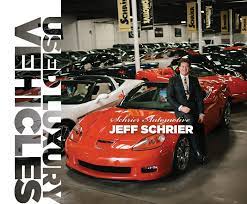A woman paid a visit to Jeff Schrier’s used auto yard in Omaha, Nebraska, a few months ago. She explained that she was on a tight budget and needed a car to get to work.
She was shown three cars that were priced at $7,500, which was her maximum. The woman, according to Schrier, was taken aback.
He recalls her responding; ′′’That’s what I get for $7,500?’ The automobiles were significantly older and had far more miles on them than she had imagined for a car that had been damaged in a catastrophe.
The woman eventually decided on a 2013 Toyota Scion with 160,000 miles on the odometer. Schrier isn’t sure if he made any money on the transaction. “All we did was help her out,” he explained.
Consider that, according to Edmunds.com, the average price of a used vehicle in the United States in November was $29,011 – a staggering 39 percent higher than just a year ago. For the first time in history, more than half of American households earn less than the amount required to purchase an average-priced used vehicle.
The days when almost everyone with a steady income could walk onto an auto lot and buy a solid late-model automobile or their child’s first car for a few thousand dollars have mostly passed them by.
“I’ve never seen anything like it – it’s insane,” said Schrier, who has worked in the auto industry for 35 years. “For a lot of folks right now, it’s extremely frustrating.”
Apart from energy, used vehicles were the biggest reason when the government revealed that consumer inflation soared 6.8% in the 12 months ending in November, the steepest increase in nearly 40 years. While the rate of increase is reducing, most experts believe that the inflated automobile prices will continue to rise in the near future.
The responsibility may be traced back to the outbreak of the epidemic in March of last year. To try to prevent the virus from spreading, auto plants have halted production. Fewer consumers swapped in used automobiles and trucks while new vehicle sales fell. Simultaneously, increased demand for laptops and monitors from individuals stranded at home prompted semiconductor manufacturers to shift output away from vehicles, which rely on such chips, and toward consumer electronics.
When a faster-than-expected economic recovery bolstered vehicle demand, automakers attempted to resume full production. Chipmakers, on the other hand, were unable to adapt quickly enough. In addition, because they were unable to obtain new vehicles, rental car firms and other fleet buyers ceased offloading older vehicles, exacerbating the used vehicle shortage.
As bad as the used-car market is, the computer chip shortage has pushed up the price of new cars. According to Edmunds.com, the typical new automobile costs around $46,000.
Even still, used car costs are anticipated to approach those of new cars. Used vehicle prices have increased by 42 percent since the pandemic began, more than double the increase in new vehicle prices. The average used vehicle cost 63 percent of the cost of a new vehicle last month. Prior to the epidemic, it was 54%.
Schrier now has to tell low-income buyers that he only has a few used cars to offer them.
“What used to be a $5,000 automobile is now $8,000,” he remarked. What was once $8,000 has now risen to $11,000 or $12,000.”
According to Edmunds, the average used vehicle now costs $520 per month, including taxes, fees, a 10% down payment, and an interest rate of roughly 7.5 percent, even when financed for nearly six years.
While Ivan Drury, a senior manager at Edmunds, does not track used vehicle costs in relation to household income, he believes November set a new low in terms of affordability.
He pointed out that the average monthly payment for a used vehicle was $413 two years ago, $382 five years ago, and $365 a decade ago. According to Drury, the average payment for a used vehicle in November was roughly the same as it was five years ago for a brand-new vehicle.
Because used car prices are so high, Karl Hogan of Canonsburg, Pennsylvania, near Pittsburgh, was able to sell his 2007 Toyota Tacoma small pickup truck with over 170,000 miles on it last month. A man from Ohio paid $6,500 for the automobile, despite its age and mileage.
Hogan was not required to lower his asking price. “I’ve got 12 other guys behind you,” he warned some would-be purchasers when they offered him less money.
Hogan had been on the other side of the equation a week before the sale when he purchased his new Tacoma. The dealer refused to lower his $38,000 asking price.
“There were three people waiting if I didn’t accept it,” Hogan explained. I couldn’t acquire any, but I really needed a new truck.”
According to David Paris, a senior manager at J.D. Power, the cost of used vehicles is strongly related to the cost of new vehicles. Despite reports from several manufacturers that computer chip supply is gradually improving, prices paid by dealers at used vehicle auctions continued to rise in November, according to Paris.
“We’re not seeing any price weakening,” he said, which is unusual for this time of year.
According to Paris, new auto dealers in the United States have roughly 1 million vehicles available, which is only about one-third of the regular supply. The majority of them have already been sold.
Prices for new vehicles are projected to stay historically high until supply returns to roughly 2 million or 2.5 million and automakers resume discounting, which might take far into 2023, given pent-up customer demand. Once the pressure on new car prices eases the pressure on used vehicle prices will eventually ease as well.
Even after that, vehicle availability will be limited because conventional sources of used automobiles, such as vehicles returned from leases and trade-ins or sold by rental firms, have virtually dried up.
Cars returning from two- and three-year leases have been a major source of nearly-new used automobiles for the past decade. But it was back when leases accounted for more than a third of new vehicle sales in the United States, a ratio that has now dropped to 22%, according to Edmunds’ Drury. Because there aren’t many new cars on the market, folks who have leases that are coming to an end are frequently buying those cars.
Rental firms, another important supplier of late-model used automobiles, are currently unable to purchase new ones and are holding on to the ones they have. Some rental firms even purchase pre-owned vehicles. Given all of these considerations, Paris anticipates a worsening of the used car shortage through 2024.
Those who want to sell a used automobile but don’t need to replace it are among the few consumers who will benefit. According to Paris, the average trade-in value in October was $9,000, which was more than double what it was a year before.
However, those with no automobiles to trade in and low salaries have few, if any, options. According to J.D. Power’s Paris, purchasers should consider a new vehicle if they can afford it. He recently managed to shave a few thousand dollars off the sticker price of a new Ram pickup, despite having to travel from the Washington, D.C., area to Philadelphia to find a willing dealer he found through internet forums.
“You can find savings across most brands if you seek hard enough and are ready to wait and travel,” he said.


















